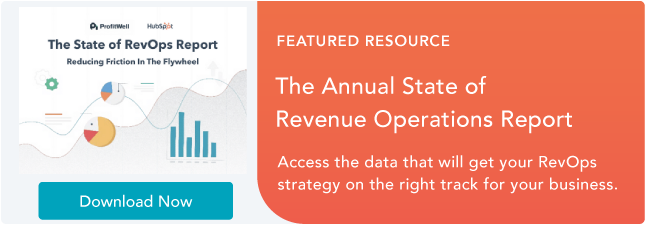Sales and marketing alignment is a hot topic for most sales and marketing organizations and has been since the beginning of business. Here on the HubSpot blog, we’ve published several posts outlining ways sales and marketing organizations can work better together.
For many companies, sales and marketing alignment efforts have been in place for a while, and for the business to grow, scale, and better support its customers, customer support organizations also need to be a part of the conversation.
If your sales and marketing organizations already work well together but want to be more intentional about supporting customers, revenue operations may bridge the gap.
Chapters
What is revenue operations (RevOps)?
Revenue Operations, also known as RevOps, is an automated business process that aligns the sales, marketing, and customer service organizations to make decisions that drive predictable revenue and promote growth.
Revenue operations is a fairly new concept, but many companies are catching on fast. According to the 2021 Forrester Study: Revenue Operations & Intelligence Report, companies adopting RO&I solutions are reaping the benefits, with 41% reporting major quantifiable revenue benefits and 69% seeing revenue benefits overall. Additionally, Director Revenue Operations, VP Revenue Operations, and Chief Revenue Officer are among the fastest-growing job titles on LinkedIn.
While the goals and tactics of a revenue operations organization could vary depending on the company’s objectives, these are some of the key metrics that measure revenue operations' success:
- Annual Recurring Revenue: a metric that shows how much recurring revenue you can expect, based on yearly subscriptions.
- Customer Lifetime Value: the total worth to a business of a customer over the whole period of their relationship.
- Customer Turnover Rate: the percentage of an organization's customer base lost during a given period of time
- Sales Cycle Time: the total number of days it takes for a deal to close, divided by the total number of closed deals
- Win Rate: the amount of success that a sales team generates over a certain period.
So now that we've established that revenue operations are becoming increasingly popular. Let's take a look at why that is.
Why Revenue Operations is So Important
The role of Revenue Operations is to ensure accountability and synchronicity among the goals and activities of organizations that are responsible for driving revenue, which is typically between sales, marketing, and customer service.
Alignment between these three groups is especially important for B2B companies. Across all industries, consistent revenue growth is a challenge for 78% of B2B companies. A well-executed Revenue Operations strategy may solve these challenges by providing companies with a centralized plan to predict revenue based on data.
How Revenue Operations Impacts Sales and Marketing
Essentially, sales and marketing alignment comes down to communication between those two separate functions. When those separate organizations have a clear delineation of work and have open, frequent communication with one another so their efforts are complementary instead of contrasting or duplicative, they can be considered aligned.
When sales and marketing organizations are aligned, there is a synergy between their organizational workflows, and processes in place outlining a clear hand-off of leads from marketing to sales.
Aligning sales and marketing teams typically occurs between the respective members of each team, along with sales enablement and marketing ops organizations.
Do you notice anything missing there? As reported in the LeanData State of Revenue Operations, 95% of B2B firms agree the ability to provide a seamless and consistent positive experience throughout the customer lifecycle is key for increasing revenue. If creating a good experience for the customer is so important, customer service must be included in the conversation.
According to the SiriusDecisions State of Revenue Operations Study, the biggest areas of misalignment for B2B companies is between their sales enablement and customer service organizations, and their marketing ops and customer service organizations. This shows a clear disconnect between how companies need to operate to keep their customers happy, and how they are currently functioning.
Revenue Operations efforts bring these entities together, providing effective cross-functional support.

While sales and marketing alignment focuses on communication needed to attract and convert customers, Revenue Operations focus on optimizing the entire customer lifecycle to increase revenue potential. Implementing a Revenue Operations strategy can be an effective way to ensure a company’s customer lifecycle is optimized to its fullest ability.
Who does revenue operations?
So, you might be thinking, "Wow, it seems like I stand to gain a lot from leveraging RevOps, but where do I start? Namely, who's supposed to be responsible for my company's revenue operations?"
Well, that's tough to say. Revenue Operations is still a relatively new concept — one that's not well-established enough for there to be any definitive structure for what a dedicated team or department is supposed to look like.
According to LeanData's State of Revenue Operations report, just 29% of companies adopting these strategies have somewhat centralized their Revenue Operations — and only 17% have been able to completely centralize theirs.
That said, there are some emerging trends and prominent roles that dictate who might be involved in RevOps efforts as the practice catches on. For one, many companies have hired a Chief Revenue Officer or CRO.
46% of central Revenue Operations teams report to the company’s Chief Revenue Officer. CROs often take on a wide variety of responsibilities that span across multiple departments — all of which play a role in revenue generation.
They can have a hand in improving sales performance, shaping pricing strategies, hashing out market segmentation, advertising, and boosting customer satisfaction. Ultimately, their day-to-day operations can be eclectic — a fitting reflection of RevOps as a practice.
Additionally, one-way revenue operators have figured out how to define and structure their RevOps org through community. Communities like HubSpot's RevOps & Operations Community serve as a virtual water cooler for today's revenue operations professionals.
Revenue Operations Adoption
As I mentioned before, Revenue Operations is still a fairly new concept. However, preliminary research shows it can be a promising approach for companies looking to break through a plateau.
Many companies are in the process of adopting a Revenue Operations strategy. Gartner, Inc predicts that by 2025, 75% of the highest growth companies in the world will deploy a revenue operations model.
To better understand Revenue Operations adoption check out this data:
- Publicly traded companies with Revenue Operations groups saw 71% higher stock performance than those that don’t.
- Companies using RO&I solutions are seeing significant optimization benefits, with 59% seeing improved win rates and 53% reporting increased net-dollar retention.
- 57% of companies that have not yet adopted a Revenue Operations strategy plan to in the future.
- The biggest challenges companies face in implementing Revenue Operations include company resources, inconsistent data, and disconnected systems.
As you can see, the data is showing some promising benefits of Revenue Operations adoption, however, there are some challenges B2B organizations must overcome to reap its benefits.
Companies with an existing revenue engine say having a lack of quality or centralized data is one of their greatest obstacles preventing them from providing a top-tier customer experience.
When implemented correctly, Revenue Operations should support the centralization of data for all teams that support the revenue engine, though it may take some work for companies to get to that point.
Centralize Your Org with RevOps
B2B companies looking to consistently bring in more revenue may want to consider prioritizing Revenue Operations to stay competitive. We hope you can optimize your company’s revenue-earning potential with this new, centralized strategy.
Editor's note: This post was originally published June 30, 2020 and has been updated for comprehensiveness.
.png?width=112&height=112&name=Image%20Hackathon%20%E2%80%93%20Horizontal%20(16).png)

![Download Now: Annual State of RevOps [Free Report]](https://no-cache.hubspot.com/cta/default/53/78dd9e0f-e514-4c88-835a-a8bbff930a4c.png)







![What is an Implementation Plan? [& How to Do Yours Right]](https://www.hubspot.com/hubfs/Implementation%20Plan%20%281%29.jpg)
